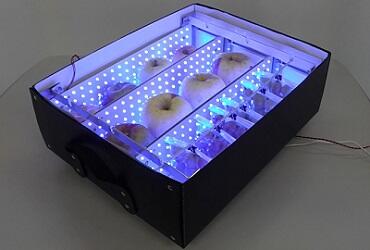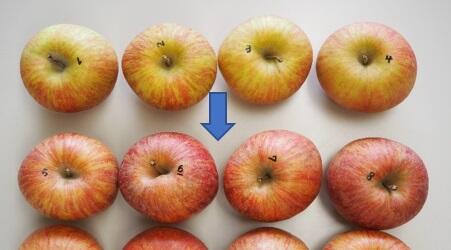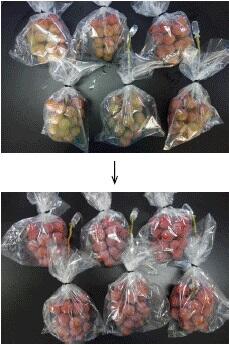Even if apples and grapes have a sufficiently high sugar content and a pleasant taste, if the color of the peel is uneven and the appearance is poor, the product value will decrease. The University of Tokyo, Yamaguchi Prefectural Industrial Technology Institute, and Institute of Fruit Tree and Tea Science, NARO (NIFTS) have jointly developed a "fruit coloration promotion device" that stimulates the red coloration of the skin of apples and red grapes that have not sufficiently developed red coloring by irradiating them with blue LED light. In areas where apples and grapes are grown, high temperatures due to global warming are causing poor coloration. This device is expected to be widely used as a tool to increase the commercial value of such poorly colored apples and grapes.
Irradiation for 5 days improves the coloring of apples
The newly developed fruit coloration promotion device is a simple box (50 cm wide, 40 cm deep, 15 cm high), divided into three rooms by partition plates equipped with a board on which many chip LEDs emitting blue light are arranged (Fig.1). These partition plates can be moved left and right depending on the shape and size of the fruit placed inside.
When this device is placed in a low-temperature refrigerated storage and the blue LED is lit, the temperature inside the device can be maintained at a temperature suitable for promoting the coloration of each fruit by adjusting the heat and the ventilation port of the device. Up to 12 apples (up to 12 cm in diameter) can be processed at a time.
In an experiment conducted by the University of Tokyo, the device was placed in a storage room, and while the temperature inside the device was kept at 15℃, blue LED light was applied to the Fuji apple cultivar for 5 days. The apples turned red, and it was confirmed that color unevenness was improved (Fig.2). By performing irradiation, more of the pigment anthocyanin contained in the peel is accumulated, and coloring progresses.
Poor coloration of apples is a concern for producers. Insufficient coloration is caused by the fact that the fruit is shaded by leaves and branches and does not receive enough light, as well as by applying too much fertilizer and growing in high temperatures. Producers use ingenious techniques such as picking leaves to ensure that the sun's rays hit the fruit evenly, changing the orientation of the fruit, and laying reflective sheets on the ground. Such efforts are hard work and do not always produce results. In recent years, there is also a problem regarding the difficulty in coloring to progress at high temperatures due to global warming.
The fruit coloration promotion device is useful as a simple method to solve such troubles of producers. No advanced technical skills are required to operate this device. Coloration promotion effects are observed in fruits with a sugar content of 13 degrees or greater.
 |
 |
| Fig.1 "Fruit coloration promotion device" that emits pale light (Provided by Yamaguchi Prefectural Industrial Technology Institute) | Fig.2 Irradiation with blue LED light improves the color unevenness of apples (upper row) to become red (lower row) (Provided by the University of Tokyo) |
Effect of coloration promotion also with red grapes
The effect of promoting coloration by blue LED light has also been demonstrated for red grapes in an experiment conducted by the Institute of Fruit Tree and Tea Science, NARO (NIFTS). Similar to the experiment with apples the red grape cultivar Queen Nina was placed in the fruit coloration development device, the temperature inside the device was maintained at 15℃-20℃, and irradiation with blue LED light was performed for 7 days. The grape skins, which were partially green due to poor coloration, improved and turned red (Fig.3). A similar coloration promotion effect was also confirmed with many red grape varieties such as Kaiji and Akamine. However, no effect was observed when the sugar content was low.
This coloration-promoting effect was demonstrated in apples and grapes.

Fig.3 Queen Nina, a grape cultivar whose coloring was improved by irradiation with blue LED light (Provided by the Institute of Fruit Tree and Tea Science, NARO [NIFTS])
Expectation that the device will be widely used
These research results were announced at the "Agribusiness Creation Fair 2021" held at Tokyo Big Sight in November 2021. Sales of the fruit coloration promotion device will be realized somewhat in the future, and Kazumasa Yoshimura, an expert researcher at the Yamaguchi Prefectural Industrial Technology Institute, who was involved in the research and development of the device, estimates that the selling price will be around 26,000 yen per unit if mass-produced in a quantity that can be expected to reduce costs.
Recently, grapes are sold in bulk at supermarkets and convenience stores. If the poorly colored grapes packed in a transparent bag are irradiated with blue LED light at a retail store to promote coloring, it may be possible to raise the price and sell them. Yoshimura has hopes for the widespread use of the device, noting that "in the future, it can also be applied to increase the product value of fruits to be exported overseas by promoting coloring during transportation and storage. If it is used not only by distributors but also by producers, it can be expected to improve agricultural income."
Project name
The special scheme project on advanced research and development for next-generation technology
Project period
FY 2016 to 2020
Title
Development of freshness preservation and cultivation technology aimed at extending the duration of supply of domestic fruits
Leading research institutes
Institute for Sustainable Agro-ecosystem Services,
Graduate School of Agricultural and Life Science, The University of Tokyo, Yamaguchi Prefectural Industrial Technology Institute, Institute of Fruit Tree and Tea Science, NARO (NIFTS)
